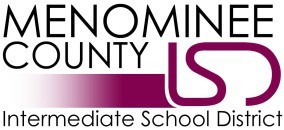Specific Learning Disabilities
The Menominee County ISD model for the identification of Specific Learning Disabilities emphasizes the full and individual evaluation as a process of data collection that includes multiple methods of assessing student performance with input from Parents, Teachers, Instructional Specialists, and School Psychologists. The purpose of the evaluation is to surround the student of concern with the best and most comprehensive information possible to make valid and appropriate recommendations as to the student’s eligibility for special education and, more importantly, educationally relevant recommendations for instructional strategies, supports and services.

Begin with considerations of Instructional Quality: Federal law requires schools to ensure that students were provided with appropriate, evidence-based instruction that is delivered by a qualified teacher. The model begins with considerations as to the provision of quality instruction delivered by qualified teachers.
Level of Proficiency State Standards: Student progress in learning State standards is a fundamental consideration for instructional planning and for understanding student educational performance levels. Next, the team considers the student’s level of proficiency with State standards, as measured by State assessments and/or district benchmarking assessments.
Rate/Level of Progress: Data representing repeated measures of student performance provided to parents at regular intervals are required to determine the probability of a specific learning disability. Repeated measures of student rate/level of progress may include progress monitoring data, benchmark assessments, classroom assessments, or other measures that occur at reasonable intervals, such as every 4 – 8 weeks.
Response to Intervention: Academic interventions, whether formalized in school procedures or through teacher efforts to provide supplementary instruction, must be documented with attention to the fidelity of the efforts to impact student achievement.
Exclusionary Factors: Before making attributions of disability within the student, the team must consider all other factors that could explain the performance patterns and the lack of student response to instruction. The team must consider the student’s progress in the context of his/her opportunity, past experiences, sensory, health, language, culture, and developmental challenges.
Diagnostic Achievement Testing: The comprehensive evaluation of the student must include normative measures to advance the understanding of why the student continues to have difficulty. The student must also be tested with an individually administered standardized achievement test to validate the samples of classroom assessment data with normative data.
Cognitive Testing: Before applying a categorical label to a student, the study of abilities must include testing of intelligence skills to identify patterns of strength and weakness that may further elucidate understanding of the student’s learning difficulties.
Goodness of Fit to SLD Patterns: The test data are then analyzed relative to research-based clinical profiles of learning disabilities to determine a goodness of fit with existing models of learning disabilities. The team considers the relationships between areas of strength and area of deficit as they relate to our most current understanding of specific learning disabilities.
Lead Back to Quality Instructional Practice: The assessment must then lead to the development of educationally relevant recommendations for the student, whether determined eligible as a student with a Specific Learning Disability or not. The evaluation must lead to appropriate recommendations as to the best plan for instruction. Recommendations should not be limited to special education supports and programs but may include such recommendations as classroom accommodations or continued participation in response to intervention targeted small group instruction.
Web Links & Documents
![]() Learning Disabilities Association of America
Learning Disabilities Association of America
![]() Bookshare
Bookshare
![]() Intervention Central
Intervention Central
![]() Curriculum Based Measurement Solutions
Curriculum Based Measurement Solutions
![]() Accommodations & Modifications
Accommodations & Modifications

